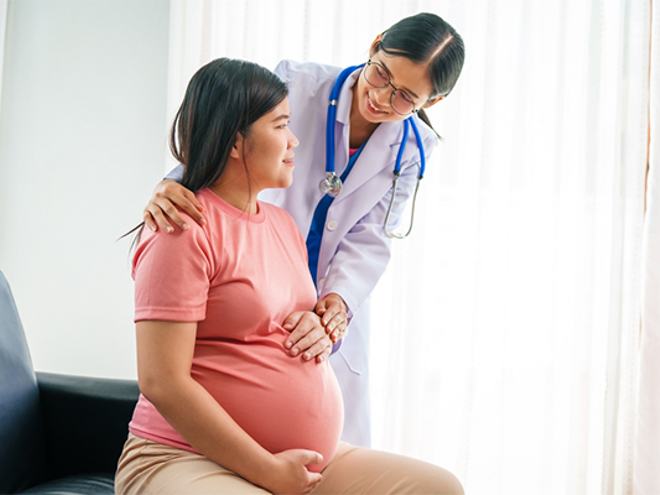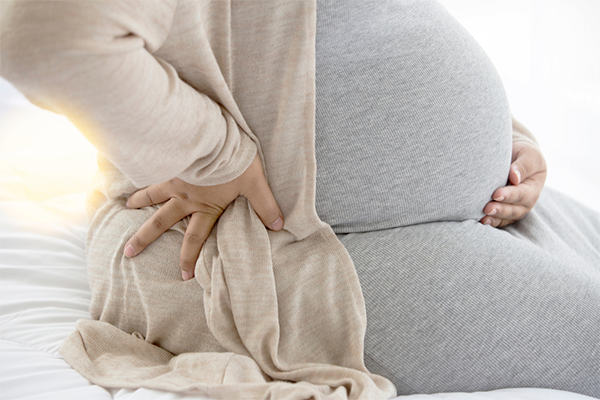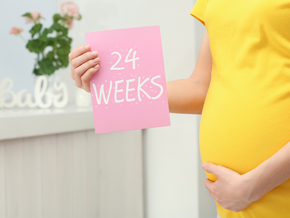
35 Weeks Pregnant: Baby's Position, Back and Hip Pain, What to Avoid
You're 35 weeks pregnant with just about a few weeks to go until your due date. You're likely counting down the days of your childbirth with excitement and a bit of trepidation.
Whether it's your first pregnancy or your third, this week can feel a little different. Here's what to know about your baby's development in the womb, pregnancy symptoms, and things best to avoid as you prepare for delivery.
Your Baby's Development at 35 Weeks
Your baby may now weigh up to 2.7 kg (6 lbs) and measure about 46 cm (18 in) from head to toe, the length of a large durian. Mayo Clinic points out that your baby has almost filled up the space in the amniotic sac now that you're 35 weeks pregnant.
Here are other developments happening to your baby, according to the American College of Obstetricians and Gynecologists (ACOG):
- The bones have hardened, but your baby's skull is still soft.
- Your baby's fingernails have extended to the tips of their fingers.
- Their limbs are starting to appear more rounded.
- The fetus may adjust to a head-down position in preparation for birth.
Your baby's skin has also become less wrinkled now as fat builds up under the skin, helping to regulate their temperature after birth.
Position in the womb
By this time, your doctor may also mention your baby's position. Ideally, they should be head-down by now. If your baby is still breech (feet or bottom first), your ob-gyn might talk to you about what to expect in the coming weeks or discuss options for turning the baby safely.
Lung development
At 35 weeks pregnant, your baby's lungs have now produced the right amount of surfactant. Stanford Medicine Children's Health says this substance is released into the lung tissues, keeping your baby's air sacs (lung alveoli) open. But your baby's lungs are still maturing and are not quite ready yet for childbirth at 35 weeks.
Start of sucking reflex
Your baby's sucking reflex, crucial to their breathing and swallowing at birth, is now developing and will become fully mature when you're 36 weeks pregnant. If your baby is born early, they can have a weak sucking ability that can affect how they feed.
Back and Pelvic Pain at Week 35 of Pregnancy

Your body is producing hormones that loosen joints and ligaments to prepare your pelvis for birth. But it also leads to pelvic and back pain.
Most women who are 35 weeks pregnant will experience some intense back or pelvic pain in the third trimester, right where you are now. Experts break this down into two types:
- Low back pain (LBP) shows up in the area between your lower ribs and your bottom.
- Pelvic girdle pain (PGP) sits deeper in your pelvis, often around your hips, tailbone, or pubic bone.
When both types show up together (which is often the case), it's referred to as lumbopelvic pain (LBPP).
A 2021 review on musculoskeletal pain published in Frontiers in Pain suggests that you're more likely to experience LBPP if you've had back problems before, a previous pregnancy with pelvic pain, or any past injury to your back or hips.
Any constant pelvic discomfort or severe back pain at 35 weeks pregnant needs medical attention. Don't wait until your next appointment to ask your ob-gyn, especially if it’s affecting how you walk or sleep.
Other Week 35 Pregnancy Symptoms
When you're 35 weeks pregnant, your symptoms may include new or familiar ones apart from lumbopelvic pain, but in a different intensity. Some of these changes occur because your body is preparing for labor.
According to the UK's NHS, some of the most common symptoms women experience around this time may include:
- Round ligament pain
- Braxton Hicks contractions (the signs of labor guide has more information on actual vs false labor)
- Frequent urination
- Headaches
- Dark skin patches on your face (chloasma)
- Painful hemorrhoids
- Heartburn and indigestion
Between the physical discomfort and anxious thoughts about labor, sleep can feel more like a series of naps at this stage. You may also feel out of breath most of the time. That may mean your baby hasn't dropped yet and is still crowding your lungs.
By this point, the symptoms you shouldn't ignore are severe pain under your ribs, persistent headaches, or significant swelling. Talk to your ob-gyn because these may signal that you have preeclampsia.
Your Nutrition at 35 Weeks
Some food items may help alleviate conditions such as Braxton Hicks contractions, heartburn, constipation, and swelling. Here are a few practical tips that may help ease your pregnancy symptoms. You can also check out these pregnancy meal plan ideas.
Stay hydrated to help with Braxton Hicks
Whether you're affected or not by Braxton Hicks, it's good to know that dehydration is one of its potential triggers, according to the Cleveland Clinic. So aim to drink plenty of water throughout the day.
Load up on fiber + fluids to fight constipation
Slowed digestion is a common issue at 35 weeks pregnant, so foods high in fiber may help. But Johns Hopkins Medicine advises making sure to hydrate anytime you increase your fiber intake, or you can end up with constipation.
Some easier-to-tolerate fiber-rich foods for pregnant women include leafy greens, fruits, and whole grains.
Cut back on salty, processed food to reduce swelling
Mild swelling in your feet or hands is common now, but it can feel uncomfortable or make you feel puffy all over. So limit salty foods, processed snacks or instant meals, and focus on potassium-rich foods like bananas and spinach. Keeping your legs elevated when you rest can be beneficial.
35 Weeks Pregnant: Signs of Labor
If labor starts when you're 35 weeks pregnant, get in touch with your doctor immediately or bring yourself to the emergency room. Here are some signs of labor to watch for:
- A noticeable increase in pelvic pressure or cramping
- Lower back pain that doesn't go away with rest
- Bloody or mucus-like vaginal discharge
- Regular contractions that don’t ease up when you change positions
Even if you're not sure whether it's labor, you want to check in with your doctor sooner rather than later just to be safe.
FAQs About Being 35 Weeks Pregnant

At 35 weeks pregnant, now's the time to go through your hospital bag with your partner or whoever will be there with you during childbirth.
If you're sorting through what's okay and what's not at 35 weeks pregnant, here are answers to a few questions moms often ask.
Is 35 weeks pregnant safe to deliver?
If you deliver at Week 35, your baby is likely to be taken to the neonatal intensive care unit. As the Australian Preterm Birth Prevention Alliance points out, every extra day in the womb gives your baby more time to grow and develop, especially their lungs and brain.
What are the things to avoid when you’re 35 weeks pregnant?
Anything that puts too much stress on your body, increases your risk of falling, or raises your blood pressure too much should be avoided. That includes:
- Heavy lifting or straining
- Long periods of standing without rest
- Overheating (due to sauna or intense workouts)
- Foods that may cause foodborne illness
- Stress if you can help it
Also, avoid long travel if your doctor hasn't cleared it, especially if you’re showing signs of early labor. This is the time to rest when you can.
Sex at 35 weeks pregnant—is it safe?
As long as you have a healthy pregnancy, ACOG notes that sex is safe unless you have been told otherwise by your doctor. That said, sex might feel different now since your belly is heavier, and some positions no longer work.
You may have waning desire to have sex in the third trimester, ACOG adds. Always ask your healthcare provider for advice, especially if you have a high-risk pregnancy.
Can I still exercise?
Yes, exercise at 35 weeks pregnant is okay as long as it feels good and your doctor hasn’t advised against it. The key is to keep it gentle; this article lists examples of light exercises in your third trimester.
If you feel dizzy, breathless, or notice contractions that don't go away after rest, it’s a sign to slow down or stop. Always err on the side of safety.
Why do I need to sleep on my left side?
Sleeping on your left side is often recommended because it takes the pressure off the main blood vessels and helps blood flow better to your baby and your major organs.
If you wake up on your back, shift to your side again. Pillows between your knees or behind your back can make side sleeping more comfortable.
As you reach the final weeks, now's a good time to review your birth plan, if you’ve made one, and start packing your hospital bag for delivery day. This expert's guide on what to pack will also help.
When you're 35 weeks pregnant, you want to feel just a little more ready, no matter when your baby decides it’s time.
What developmental milestone are you often worried about? Share your thoughts on the ParentTeam Moms and Dads Facebook Group!
References
“Content - Health Encyclopedia - University of Rochester Medical Center.” Accessed October 13, 2025. https://www.urmc.rochester.edu/encyclopedia/content?ContentTypeID=90&ContentID=P02630
“Fetal Development: MedlinePlus Medical Encyclopedia.” Accessed October 13, 2025. https://medlineplus.gov/ency/article/002398.htm
Health Promotion Board. “What Happens in the Third Trimester,” November 15, 2022. Accessed October 13, 2025. https://www.healthhub.sg/well-being-and-lifestyle/pregnancy-and-infant-health/pregnancy-what-happens-in-the-third-trimester
Tommy’s The Pregnancy and Baby Charity. “Sleep Position in Pregnancy Q&A.” Tommy’s, September 5, 2023. Accessed October 13, 2025. https://www.tommys.org/pregnancy-information/im-pregnant/sleep-side/sleep-position-pregnancy-qa




























